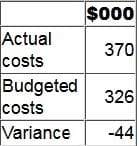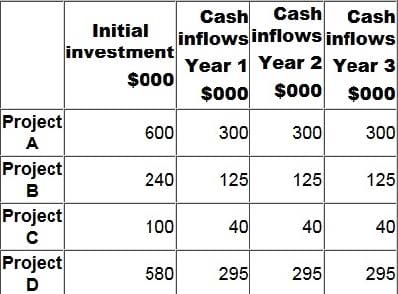Exam Details
Exam Code
:CIMAPRO19-P02-1Exam Name
:P2 - Advanced Management AccountingCertification
:CIMA CertificationsVendor
:CIMATotal Questions
:202 Q&AsLast Updated
:Jun 29, 2025
CIMA CIMA Certifications CIMAPRO19-P02-1 Questions & Answers
-
Question 131:
A cost centre manager's performance is monitored based on a comparison of actual and budgeted cost. A summary performance report for the latest period is shown below.

The actual costs include:
*$28,000 for allocated head office costs.
*$18,000 payment for a rental agreement entered into by the cost centre manager two years ago.
*$34,000 for depreciation.
What is the cost centre manager's controllable actual cost for the period? Give your answer to the nearest $000.
A. $308000
-
Question 132:
The following information is available for four investment projects:

A discount rate of 12% is appropriate for all four projects. The organization is subject to capital rationing and wishes to prioritise the projects using the profitability index (PI). Which project has the highest PI?
A. Project A
B. Project B
C. Project C
D. Project D
-
Question 133:
An organization has the right to mine for gold on its land. The price of gold and the cost of extraction are such that mining is not currently financially viable. However, the organization has the right to commence mining at any time in the future
if the price of gold increases and makes mining financially viable.
This right to commence mining in the future is an option to:
A. abandon
B. redeploy
C. expand
D. delay
-
Question 134:
An organization wants to increase the use value that customers place on one of its products - a laptop computer. Which of the following actions, taken to increase the value to the customer, would increase the product's use value? Select ALL that apply.
A. Launching a marketing campaign designed to build the company's brand.
B. Installing a touch screen to improve the computer's functionality.
C. Changing the color of the computer's case.
D. Adopting a premium pricing strategy for the computer.
E. Fitting advanced components to improve the computer's performance.
-
Question 135:
In order to support decision making, management accounting information categorizes costs in a variety of ways. Responsibility accounting primarily distinguishes between costs on the basis that they are either:
A. sunk or opportunity costs
B. fixed or variable costs
C. controllable or uncontrollable costs
D. relevant or non-relevant costs
-
Question 136:
Which TWO of the following actions taken during the budgetary planning process will result in the creation of budgetary slack?
A. Overestimating costs
B. Underestimating costs
C. Underestimating revenues
D. Overestimating revenues
E. Overestimating profit
-
Question 137:
In order to remain competitive an organization wishes to achieve cost savings for one of its existing products. Which of the following correctly describes methods which the organization can use to achieve these cost savings? Select ALL that apply.
A. Functional analysis is carried out only on existing products and is concerned only with minimizing the cost of the originally defined functions of a product.
B. Value engineering is a fundamental rethinking and radical redesign of an organization's existing processes.
C. Target costing is continuously setting new stretch targets while the product is in production.
D. Value analysis is examining a product's costs in order to achieve its purpose at a reduced cost while maintaining its reliability and quality.
E. Kaizen costing is seeking to make cost savings by continuously making small incremental cost reductions while the product is in production.
-
Question 138:
An organization wishes to achieve cost reductions for a product it already has in production without affecting the customer's perception of the product.
It has decided to carry out a systematic examination of the factors affecting the cost of the product in order to identify ways of achieving the specified purpose at lower cost while maintaining the required standard and quality.
Which of the following correctly identifies the activity that the organization is undertaking?
A. Value analysis
B. Kaizen costing
C. Standard costing
D. Process innovation
-
Question 139:
A public sector service organization is considering whether to use a balanced scorecard or a value for money approach based on the three Es to assess its performance. Which of the following are correct comparisons of the balanced scorecard and value for money based on the three Es as performance measurement frameworks? Select ALL that apply.
A. Efficiency is measured as one of the three Es but the balanced scorecard does not measure efficiency.
B. If the organization wishes to consider both financial and non-financial performance then the balanced scorecard should be used rather than the three Es.
C. The public's satisfaction with the organization's services can be measured by both the three Es and the balanced scorecard.
D. The balanced scorecard is concerned with meeting the organization's objectives whereas the three Es approach is concerned only with reducing costs.
E. The three Es approach was designed for public sector service organizations, but the balanced scorecard approach can also be used in the public sector.
-
Question 140:
There is a 60% probability of a project yielding a positive net present value (NPV) of $280,000 and a 30% probability of it yielding a positive NPV of $140,000. The only other possible outcome is that the project will yield a negative NPV of
$160,000.
What is the expected value of the project's NPV?
A. $194,000
B. $210,000
C. $280,000
D. $260,000
Related Exams:
CIMA-BA1
BA1 - Fundamentals of Business EconomicsCIMA-BA2
BA2 - Fundamentals of Management AccountingCIMA-BA3
BA3 - Fundamentals of Financial AccountingCIMA-BA4
BA4 - Fundamentals of Ethics, Corporate Governance and Business LawCIMA-CS3
CS3 - Strategic Case Study 2021CIMA-E1
E1 - Managing Finance in a Digital WorldCIMA-E2
E2 - Managing PerformanceCIMA-E3
E3 - Strategic ManagementCIMA-F1
F1 - Financial ReportingCIMA-F2
F2 - Advanced Financial Reporting
Tips on How to Prepare for the Exams
Nowadays, the certification exams become more and more important and required by more and more enterprises when applying for a job. But how to prepare for the exam effectively? How to prepare for the exam in a short time with less efforts? How to get a ideal result and how to find the most reliable resources? Here on Vcedump.com, you will find all the answers. Vcedump.com provide not only CIMA exam questions, answers and explanations but also complete assistance on your exam preparation and certification application. If you are confused on your CIMAPRO19-P02-1 exam preparations and CIMA certification application, do not hesitate to visit our Vcedump.com to find your solutions here.